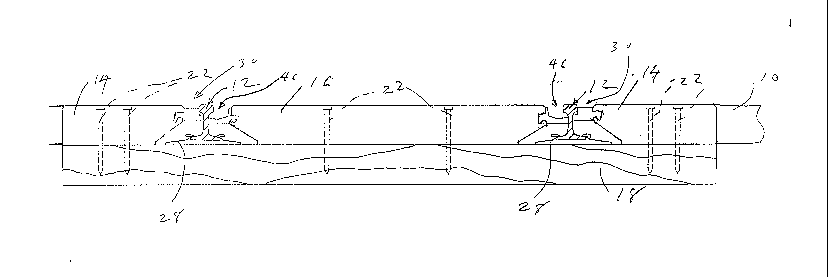Some of the information on this Web page has been provided by external sources. The Government of Canada is not responsible for the accuracy, reliability or currency of the information supplied by external sources. Users wishing to rely upon this information should consult directly with the source of the information. Content provided by external sources is not subject to official languages, privacy and accessibility requirements.
Any discrepancies in the text and image of the Claims and Abstract are due to differing posting times. Text of the Claims and Abstract are posted:
| (12) Patent Application: | (11) CA 2178886 |
|---|---|
| (54) English Title: | CONCRETE GRADE CROSSING PANELS HAVING INTEGRAL ELASTOMERIC SEALS |
| (54) French Title: | PANNEAUX EN BETON AVEC GARNITURES EN ELASTOMERE INCORPOREES POUR PASSAGES A NIVEAU |
| Status: | Deemed Abandoned and Beyond the Period of Reinstatement - Pending Response to Notice of Disregarded Communication |
| (51) International Patent Classification (IPC): |
|
|---|---|
| (72) Inventors : |
|
| (73) Owners : |
|
| (71) Applicants : |
|
| (74) Agent: | OYEN WIGGS GREEN & MUTALA LLP |
| (74) Associate agent: | |
| (45) Issued: | |
| (22) Filed Date: | 1996-06-12 |
| (41) Open to Public Inspection: | 1997-01-06 |
| Examination requested: | 1996-06-12 |
| Availability of licence: | N/A |
| Dedicated to the Public: | N/A |
| (25) Language of filing: | English |
| Patent Cooperation Treaty (PCT): | No |
|---|
| (30) Application Priority Data: | ||||||
|---|---|---|---|---|---|---|
|
A rail grade crossing includes precast concrete
panels which extend substantially between the roadway and
the rails and between the rails. Elastomeric seals that
are cast into the panels when they are formed fit between
the panels and the rails. Because the seals are cast
into the panels, the panels and seals are an integral
unit which facilitates installation and removal of the
panels.
Note: Claims are shown in the official language in which they were submitted.
Note: Descriptions are shown in the official language in which they were submitted.

2024-08-01:As part of the Next Generation Patents (NGP) transition, the Canadian Patents Database (CPD) now contains a more detailed Event History, which replicates the Event Log of our new back-office solution.
Please note that "Inactive:" events refers to events no longer in use in our new back-office solution.
For a clearer understanding of the status of the application/patent presented on this page, the site Disclaimer , as well as the definitions for Patent , Event History , Maintenance Fee and Payment History should be consulted.
| Description | Date |
|---|---|
| Inactive: IPC from MCD | 2006-03-12 |
| Inactive: IPC from MCD | 2006-03-12 |
| Inactive: IPC from MCD | 2006-03-12 |
| Application Not Reinstated by Deadline | 1999-12-09 |
| Inactive: Dead - No reply to s.30(2) Rules requisition | 1999-12-09 |
| Deemed Abandoned - Failure to Respond to Maintenance Fee Notice | 1999-06-14 |
| Inactive: Abandoned - No reply to s.30(2) Rules requisition | 1998-12-09 |
| Inactive: S.30(2) Rules - Examiner requisition | 1998-06-09 |
| Inactive: Status info is complete as of Log entry date | 1998-03-24 |
| Inactive: Application prosecuted on TS as of Log entry date | 1998-03-24 |
| Application Published (Open to Public Inspection) | 1997-01-06 |
| All Requirements for Examination Determined Compliant | 1996-06-12 |
| Request for Examination Requirements Determined Compliant | 1996-06-12 |
| Abandonment Date | Reason | Reinstatement Date |
|---|---|---|
| 1999-06-14 |
The last payment was received on 1998-05-25
Note : If the full payment has not been received on or before the date indicated, a further fee may be required which may be one of the following
Patent fees are adjusted on the 1st of January every year. The amounts above are the current amounts if received by December 31 of the current year.
Please refer to the CIPO
Patent Fees
web page to see all current fee amounts.
| Fee Type | Anniversary Year | Due Date | Paid Date |
|---|---|---|---|
| Request for examination - standard | 1996-06-12 | ||
| MF (application, 2nd anniv.) - standard | 02 | 1998-06-12 | 1998-05-25 |
Note: Records showing the ownership history in alphabetical order.
| Current Owners on Record |
|---|
| OMNI PRODUCTS, INC. |
| Past Owners on Record |
|---|
| JACK WILLIAMS |